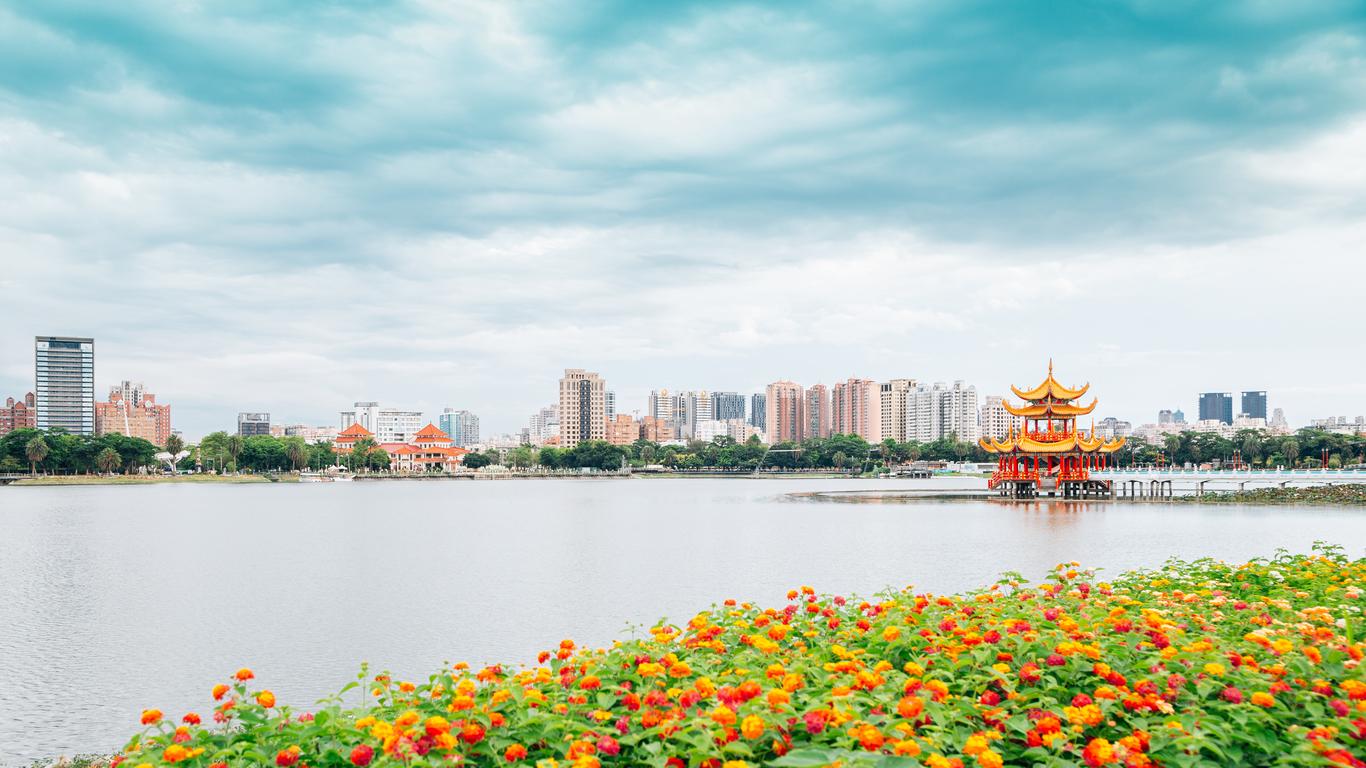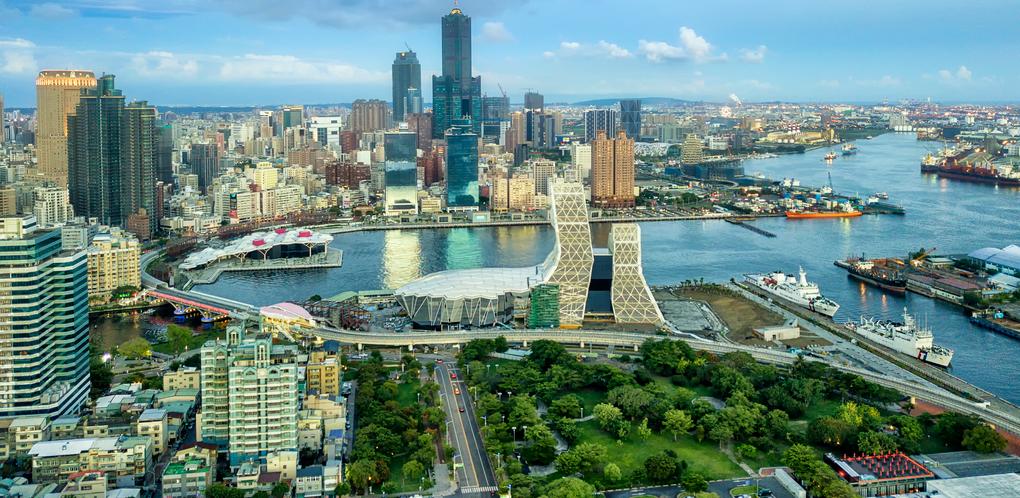
Kaohsiung City travel guide
Kaohsiung City Tourism | Kaohsiung City Guide
You're Going to Love Kaohsiung City
Once a small fishing village, Kaohsiung today offers plenty of activities with its beaches, cafes, and wide streets.

The city represents a surprising contrast between its ancient temples and more modern structures such as the Dream Mall. Kaohsiung is a great base for side-trips if you want to see the more rural parts of the island or explore the west coast.
Top 5 Reasons to Visit Kaohsiung City
1. The Cijin District
The Cijin District is an island across from the harbor. Take a ferry and relax at the beach or try one of the many snack stands or seafood restaurants.
2. The Cihou Lighthouse
The Cihou Lighthouse is an example of Baroque architecture that dates back to the late 19th century and the Qing Dynasty.
3. Fo Guang Shan and the Tianhou Temple
Fo Guang Shan is one of the largest Buddhist monasteries in the world. The Tianhou Temple is a 300-year-old temple where you can see folk art.
4. Shop at the Dream Mall
The Dream Mall is the largest shopping mall in Taiwan. If you get tired of shopping, hop on the Ferris wheel to see the city from above.
5. The Shoushan Monkey Mountain
You can hike on the Shoushan Monkey Mountain and observe monkeys in the wild. Some of them are not afraid to approach people and will grab snacks from you!
What to do in Kaohsiung City
1. A Unique Testament To Everyday Creativity
Surely one of the most idiosyncratic Taoist temples anywhere in the world, Tiánliáo was constructed by a gang of migrant road workers after their bosses went bust. Instead of resting on their tools, they collaborated with a small neighborhood temple and created something astonishing. Its shell and stone encrusted walkways and verandahs remind you more of Gaudi's Barcelona than Asian traditions, while visitors are treated to daily vegetarian feasts as part of the package, making it all pretty hard to resist.
2. From Warehouses To Artistic Wonderland
Modern-day Kaohsiung is one of Taiwan's artistic hubs, and nowhere is this more clearly on display than Pier 2 - the city's most dynamic district. Located in the Yangcheng neighborhood, Pier 2 was originally an industrial warehouse. However, the economy shifted and the space became derelict. But artists swooped in, and Pier 2 was born in 2006. Nowadays, it's a forest of art spaces, clothing boutiques, and musical performance spaces, and a key place for local talent to show off its design chops. There's even a toy train ride for kids to enjoy while the adults peruse the artworks.
3. Savor Some Snacks In True Taiwanese Style
Kaohsiung is a bustling commercial center, and much of its activity is centered around a series of "night markets." While Xinjuejiang is probably the place to head for clothes shopping, Ruifeng is more appetizing still, with its massive selection of street food stalls. Head down to the Yucheng Road to try Taiwanese snacks like Angel Chicken, aromatic deep fried tofu, and even western fusion dishes like quesadilla burgers. Whatever your taste extends to, Ruifeng is the place to go.
4. Make It Your Mission To See This Missionary Hub
Located around 30 miles northeast of Kaohsiung City, Fo Guang Shan is an unmissable religious site. This time around, things are more conventional, but just as impressive. The largest Buddhist monastery in Taiwan, Fo Guang Shan is the center for a global missionary movement, and it's a thriving place. When you get there, the seated golden Buddha is the first thing you'll notice, but there are other treasures on-site, including the row of eight pagodas along the "Way to Buddhahood" and the Buddha Memorial Center, which boasts a rare Buddha tooth relic.
5. History And Relaxation In One Heady Mix
Situated in the Zuoying neighborhood, Lotus Lake was built in the 1950s and now serves as Kaohsiung's premier recreational spot. Attractions around the fringes of the lake include the Dragon and Tiger Pagodas, and the Spring and Autumn Pavilions with their fearsome dragon sculptures, but there's more here to enjoy than temples. The whole lake is ringed by a 2 mile long cycle path, while you can also see the centuries-old city walls of Fengshan, and a 17th century Confucian temple. It's a wonderful place to wander and absorb some history.
1. A Unique Testament To Everyday Creativity
Surely one of the most idiosyncratic Taoist temples anywhere in the world, Tiánliáo was constructed by a gang of migrant road workers after their bosses went bust. Instead of resting on their tools, they collaborated with a small neighborhood temple and created something astonishing. Its shell and stone encrusted walkways and verandahs remind you more of Gaudi's Barcelona than Asian traditions, while visitors are treated to daily vegetarian feasts as part of the package, making it all pretty hard to resist.
2. From Warehouses To Artistic Wonderland
Modern-day Kaohsiung is one of Taiwan's artistic hubs, and nowhere is this more clearly on display than Pier 2 - the city's most dynamic district. Located in the Yangcheng neighborhood, Pier 2 was originally an industrial warehouse. However, the economy shifted and the space became derelict. But artists swooped in, and Pier 2 was born in 2006. Nowadays, it's a forest of art spaces, clothing boutiques, and musical performance spaces, and a key place for local talent to show off its design chops. There's even a toy train ride for kids to enjoy while the adults peruse the artworks.
3. Savor Some Snacks In True Taiwanese Style
Kaohsiung is a bustling commercial center, and much of its activity is centered around a series of "night markets." While Xinjuejiang is probably the place to head for clothes shopping, Ruifeng is more appetizing still, with its massive selection of street food stalls. Head down to the Yucheng Road to try Taiwanese snacks like Angel Chicken, aromatic deep fried tofu, and even western fusion dishes like quesadilla burgers. Whatever your taste extends to, Ruifeng is the place to go.
4. Make It Your Mission To See This Missionary Hub
Located around 30 miles northeast of Kaohsiung City, Fo Guang Shan is an unmissable religious site. This time around, things are more conventional, but just as impressive. The largest Buddhist monastery in Taiwan, Fo Guang Shan is the center for a global missionary movement, and it's a thriving place. When you get there, the seated golden Buddha is the first thing you'll notice, but there are other treasures on-site, including the row of eight pagodas along the "Way to Buddhahood" and the Buddha Memorial Center, which boasts a rare Buddha tooth relic.
5. History And Relaxation In One Heady Mix
Situated in the Zuoying neighborhood, Lotus Lake was built in the 1950s and now serves as Kaohsiung's premier recreational spot. Attractions around the fringes of the lake include the Dragon and Tiger Pagodas, and the Spring and Autumn Pavilions with their fearsome dragon sculptures, but there's more here to enjoy than temples. The whole lake is ringed by a 2 mile long cycle path, while you can also see the centuries-old city walls of Fengshan, and a 17th century Confucian temple. It's a wonderful place to wander and absorb some history.
Where to Eat in Kaohsiung City
Head to Gang Yuan Beef Noodles for a traditional eatery experience. Boston and Pasadena French Cuisine are excellent choices for upscale dining. An affordable meal should cost NT$80, while a meal in an upscale restaurant can cost NT$500 or more.
When to visit Kaohsiung City
The weather in Kaohsiung is pleasant all year round. Temperatures are usually colder in January and February but the weather is still mild.
How to Get to Kaohsiung City
Plane
The Kaohsiung International Airport (KHH) is located 5 miles south of the city center. A taxi from the airport to the city center will cost NT$300, or take the Mass Rapid Transit Red subway line.
Train
Kaohsiung is connected to the Taiwan High Speed Rail. You can take the train between Taipei and Kaohsiung for NT$1,500.
Car
Follow Expressway 1 from any of the cities located on the west coast to reach Kaohsiung.
Bus
Riding the bus is a convenient way to travel between the main cities in Taiwan. You can take the bus from Taipei to Kaohsiung for NT$530.
Airlines serving Kaohsiung City
Where to stay in Kaohsiung City
Qianzhen District - this is the place to go if you want to shop; head to Dream Mall and the Kaisyuan Night Market.
Popular Neighborhoods in Kaohsiung
Gushan District - this is where you will find the Shoushan National Nature Park and the Shoushan Zoo. The Kaohsiung Museum of Fine Arts lies north of the park.
Cijin District - check out the Cihou lighthouse, the Seaside Park beach, the Tianhou temple, or try one of the many seafood restaurants.
Where to stay in popular areas of Kaohsiung City
Most booked hotels in Kaohsiung City
How to Get Around Kaohsiung City
Public Transportation
The Kaohsiung MRT subway system includes two lines that are connected to several bus stops. Fare is based on distance and starts at NT$20.
Taxi
Taxis are a convenient way to get around Kaohsiung. Fare starts at NT$85 and an additional NT$30 per mile thereafter.
Car
You will find some Avis outlets at the airport where you can rent a car for approximately NT$20,000 a day. Renting a scooter will cost you NT$400 to NT$600 a day.
The Cost of Living in Kaohsiung City
Shopping Streets
The Dream Mall and E-DA Outlet Mall are the best places to shop for clothes, accessories, and electronics. The Rueifeng and Liuhe night markets are great for souvenir hunting.
Groceries and Other
You will find Carrefour and Jason's Market Place everywhere in the city. Expect to spend NT$40 for a loaf of bread and NT$250 for a pound of ground beef.
